
30 minute read
Artists in the Exhibition
29
Dave Hullfish Bailey
Advertisement
“The habits of mind have been sedimented as well as the habits of using the land.” —Dave Hullfish Bailey
“Land use” is not an especially vivid term. A cousin to “land management,” it suggests a drily utilitarian view of the environment, coding the earth as a resource freely available to human operation—and also, more darkly, as a meek accomplice in the operations of industrial extraction, real-estate development, and colonial extermination. A dissenter from this regime of spatial abstraction, Dave Hullfish Bailey asks us to consider how the land might be released from the burden of functionality, countering the mapmaker’s worldview with a proliferation of “speculative geography,” as he describes his practice, which combines rigorous place-based research with sideways leaps of imagination and invention.
Bailey’s projects often take the form of DIY propositions—jerry-rigged models of technological and pedagogical systems—for remapping and redressing environmental (and social) damage. Between 1996 and 2005, he developed a project to convert the Schindler House, an iconic example of California’s modern architecture (currently home to the MAK Center for Art and Architecture, Los Angeles), into an emergency shelter. Beginning in 2006, Bailey and the late Aboriginal writer and activist Sam Watson collaborated on a project to reroute the itinerary of ferry boats in Brisbane, Australia, honoring a sacred site along the riverbank. And in his 2018 exhibition Hardscrabble at REDCAT, Los Angeles, Bailey turned his attention to models of alternative education nested in the rural hinterlands of the western United States—a preoccupation that also informs his project for Climate Changing. DM
Chris Burden
Shoot is the title of Chris Burden’s best-known artwork, a 1971 performance in which he willingly sustained a gunshot wound to his arm delivered by a friend at close range. Perhaps appropriately, the term “shoot” also holds currency in the world of professional wrestling, referring to a wrestler’s unintentional departure from the scripted performance. As a young artist in Los Angeles, Burden treated art in ways not unlike pro wrestling, combining masochistic feats (the artist traps himself in a school locker!—he crawls over broken glass!—he lies motionless under a tarp alongside a busy road!) with shameless self-promotion, even placing his own name at the end of a list of world-famous artists in his 1976 TV commercial Chris Burden Promo.
Refusing to break character (in wrestling terms, Shoot was not “a shoot,” as the plan went off as scripted), Burden tested both the audience’s complicity and the limits of institutional liability, sounding the horizons of permissible harm. In the late 1970s Burden turned from live performance to video and sculpture, and then from sculpture to architectural models and installations, including Wexner Castle (1990). The slapstick monumentality of Burden’s architectural projects—they include a mock carnival ride marrying the Eiffel Tower with two replicas of the Titanic and a rudimentary skyscraper just short enough to pass Los Angeles code restrictions—resonates with theorist Sianne Ngai’s notion of the gimmick, which she posits as “capitalism’s most successful aesthetic category but also its biggest embarrassment and structural problem.”* Disturbingly, Ngai argues, gimmicks reveal the operations of labor-sparing and pleasure-cheapening at work within the economy’s profit-driven core. As performances of radical devaluation (of the artist’s body, per Shoot, and of postmodernist architecture, in Wexner Castle), Burden’s interventions expose what most cultural institutions—the Wex among them—prefer to keep hidden: a capacity, and even a repressed yen, for vulgarity. DM
*Sianne Ngai, Theory of the Gimmick: Aesthetic Judgment and Capitalist Form (Cambridge, MA: Harvard University Press, 2020), 2.
Abraham Cruzvillegas
The words “provisional” and “improvisational” derive, in part, from the Latin verb providere—to see, or look, ahead. Mexican artist Abraham Cruzvillegas seems to hold all of these terms in mind while creating his artworks, which often take the form of architectural structures but may also resemble assemblages, games, tools, or instructions. Cruzvillegas has built his practice around the concept of autoconstrucción, or self-construction, an idea borrowed from the ad hoc architectures built (and constantly renovated and expanded) in Colonia Ajusco, the Mexico City neighborhood of his youth. Buildings there, it seems, are never quite finished,
Dave Hullfish Bailey, Thinking Outwird (from Drop City site), 2021. Digital collage, dimensions variable. Courtesy of the artist. Image description: Cross section of a digital rendering of a trailer made up of many colored lines and shapes. The trailer is digitally collaged onto a desaturated photograph of tall grasses.
Image description: Abstract forms hand drawn with black lines on a white background.

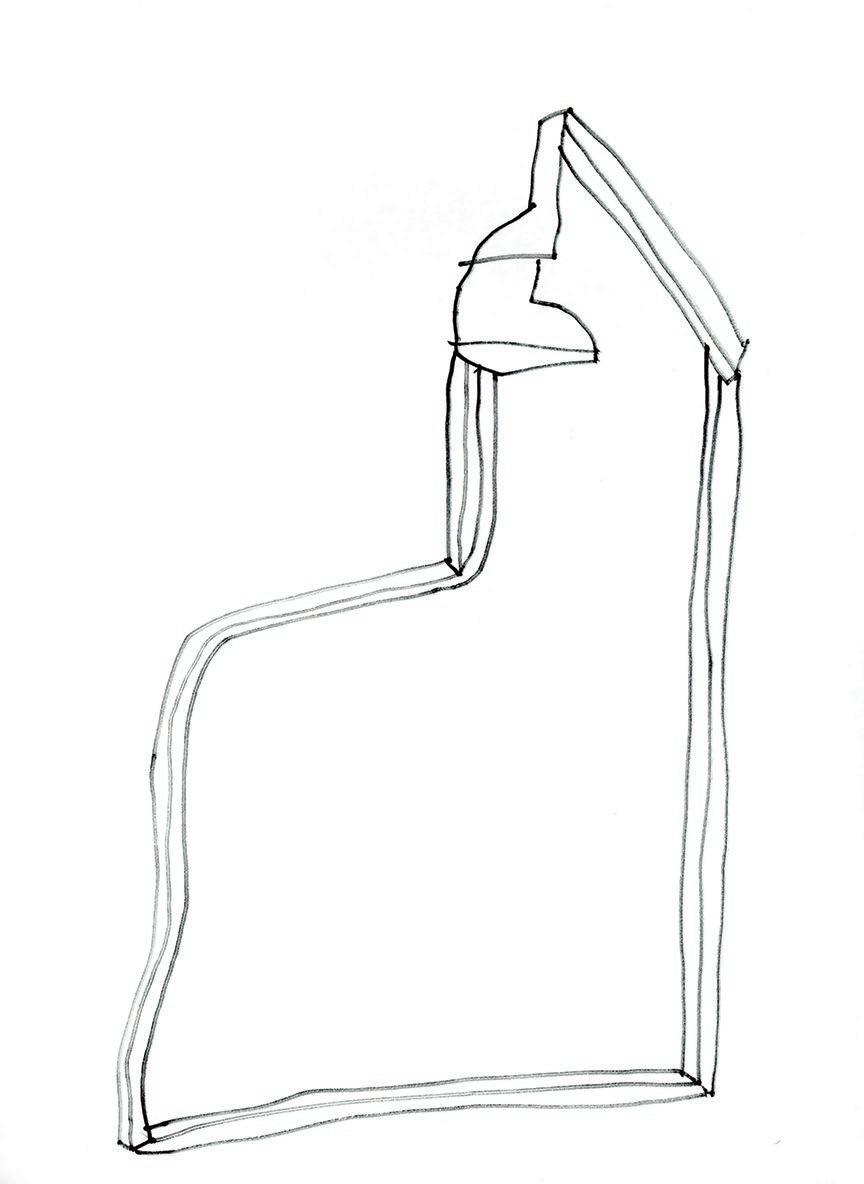
FROM LEFT TO RIGHT
Abraham Cruzvillegas, Untitled Sketches for Climate Changing 3 and 5, 2020. Courtesy of the artist and kurimanzutto, New York and Mexico City. 30
31

Torkwase Dyson, Liberation Scaled (Bird and Lava), 2020. Charcoal, acrylic, oil stick, graphite, and collage, 102 x 91 in. Courtesy of the artist and Pace Gallery, New York. Image description: An abstract, mixed-media work that includes various geometric forms including circles and semicircles, trapezoids, and triangles. A small trapezoidal shape under a circle is repeated many times in the composition.
offering some promise of continued evolution through their incompleteness.
Like the residences of his childhood neighborhood, Cruzvillegas’s conceptual and physical structures are conceived with flexibility, adaptability, and transparency built-in. Born of both necessity and opportunity, Cruzvillegas’s sculptures and environments incorporate found, repurposed resources that reflect the material vernaculars of their places of origin. Objects are transformed and cobbled together into forms that fulfill an immediate, if temporary, purpose. The possibility for transformation, growth, augmentation, or interpretation inflects Cruzvillegas’s creations with an openness that mirrors his vision for social and communal configurations. The artist often speaks of his own identity as a sort of autoconstrucción—one formed intentionally but continually, adapting to the demands of the present. LRHG
Demian DinéYazhi´
A recent Instagram post by @riseindigenous—an account run by the collective R.I.S.E: Radical Indigenous Survivance & Empowerment, the brainchild of artist/curator/writer Demian DinéYazhi´—superimposes the slogan RE“THEY”TRIATE THE LAND over a photograph of a scrubby desert plant. Phrased this way, “they” carries several meanings, invoking contemporary genderqueer and nonbinary terminology in tandem with the multiplicity of gender positions and identities available within many Indigenous societies, including DinéYazhi´’s ancestral Diné (Navajo) people, the point being to restore native sovereignty and gender fluidity in tandem.
In DinéYazhi´’s transdisciplinary practice, the pronoun “I” is always already multiple: history saturates the self, and the individual (Indigenous) body bears colonization’s toxins in its veins—a condition rendered literal in their agitprop poster POZ SINCE 1492 (2016), its slogan linking HIV/AIDS with Christopher Columbus. This slippage between singular and plural is often conveyed through the play between image and text: their 2016 video American Bondage West opens with a black-and-white photograph of a stream entering the Pacific Ocean accompanied by the caption, “THE CURVE OF AN ARMPIT.” Later in the video, the words “THE LABOR OF ASSIMILATION” overlay a photo of a leather-clad figure’s bare bottom, harnessing the pain/pleasure of bondage as a metaphor for colonial subjection. DM
Torkwase Dyson
“[H]ow do Black people survive abstraction today as the scope, scale, and density of matter is changing all around us due to climate change?” —Torkwase Dyson
Wexner Center Artist Residency Award recipient Torkwase Dyson’s abstraction spans a nexus of systems and issues such as climate change, migration and fugitivity, architecture, and infrastructure and brings these topics into conversation with both historical and contemporary meditations on Black and brown people’s spatial practices and strategies of liberation. Dyson has a system of her own, Black Compositional Thought, as well as a geometric vernacular, the Hypershapes, both of which take into account the lived experience and movement of BIPOC populations through natural and built environments.
Her investigations that raise questions of embodiment echo scholar Sara Ahmed’s writing on phenomenology: “failed orientations, when bodies inhabit spaces that do not extend their shape, means that something happens other than the reproduction of matter” or of what already exists.* Indeed, Dyson’s work might be understood as an exercise in disorientation. Rather than replicating the tragedy of being raced and erased, or not being accepted into a world that has propped up white supremacy in her work, Dyson turns her attention to “that something other” that happens, to the genius and agency of Black people, and how both historic and future models of resistance and resilience might be envisioned and put into practice. LZ
*Sara Ahmed, Queer Phenomenology: Orientations, Objects, Others (Durham, NC: Duke University Press, 2006), 147.
Futurefarmers
Founded by Amy Franceschini in San Francisco in the mid-1990s, the collective Futurefarmers has no stable roster of members. Nor does it hold a fixed conception of its overall project. Rather, the collective constitutes itself according to the needs of the project at hand. Usually catalyzed through an invitation to share work with the public, the group forms and re-forms based on the parameters of each new project, inviting new collaborators and incorporating their capabilities into a communal, open structure. This ever-evolving collective has included artists, designers, farmers, anthropologists, ecologists, sailors, architects, and philosophers—alongside many others.
Drawing from the strengths of many, Futurefarmers’ practice is rooted in research and inquiry. Its collective brand of research, however, aims to preserve and even privilege uncertainty rather than to arrive at unconditional conclusions. Futurefarmers is interested in forms of transmission, systems of knowledge, and in the discourse of “the commons”—cultural and natural resources that are shared freely. Its members 32
33
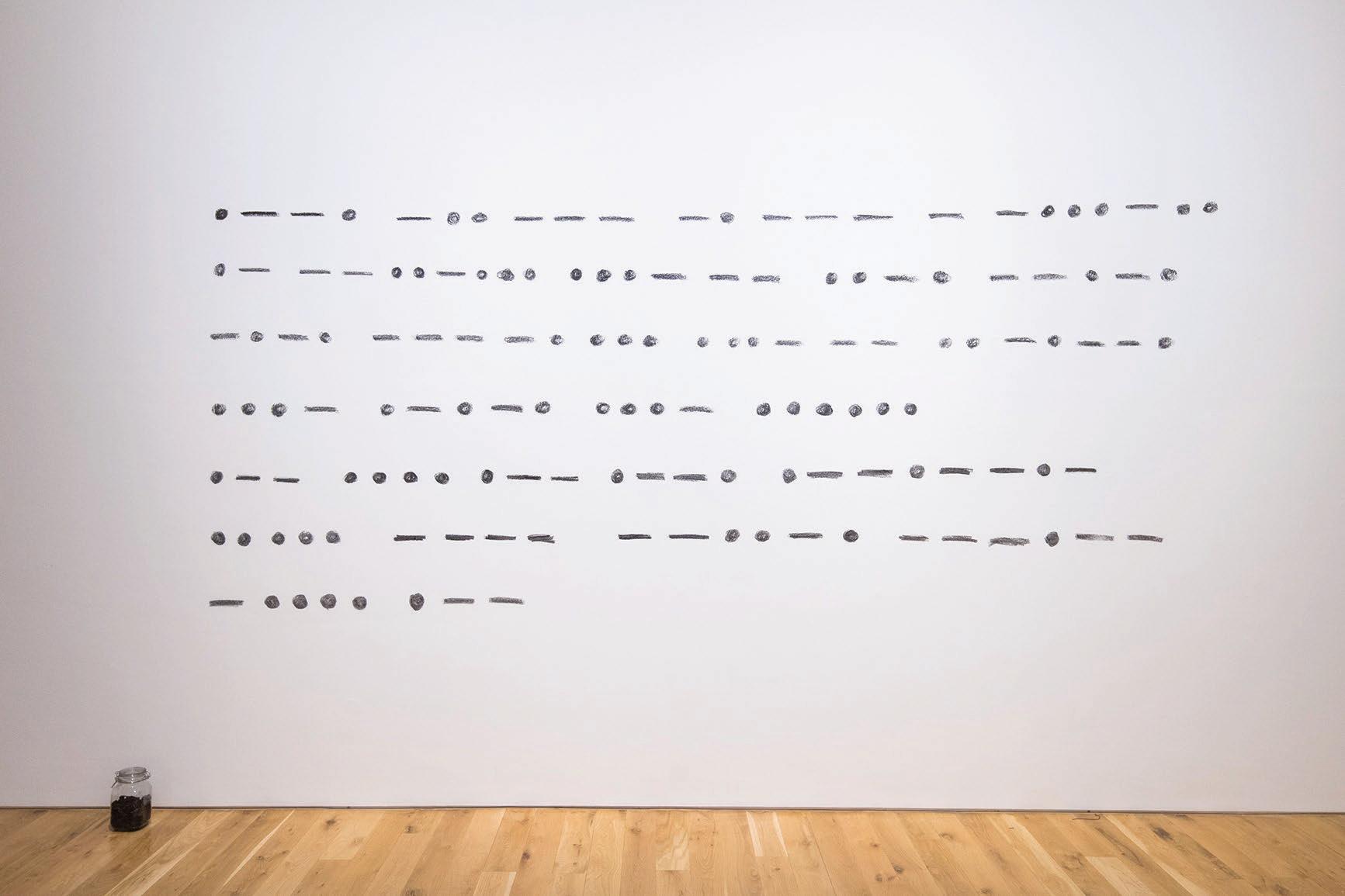
Futurefarmers, Morse message sent by Johan Swård: “We do not need museums to preserve varieties What we want is to grow them.”, 2016. Mural with charcoal from oven archive. Image courtesy of the artists. Image description: A morse code message drawn as a mural in charcoal on a white gallery wall. A glass jar filled with charcoal sits on the floor to the left of the mural.

Futurefarmers attaching SSTV antennae to Mast, 2016. Image courtesy of the artists, photo: Amy Franceschini.
Image description: A docked wooden sailboat with its sails lowered. A person climbs the lines near the mast to install an antenna. Two people stand below on the boat deck to assist. Futurefarmers, Map of Seed Journey, 2017. Watercolor on paper by Amy Franceschini, dimensions variable. Courtesy of the artists.
Image description: A black-and-white watercolor map of the European Union, the western part of Eastern Europe, and Northern Africa. Lines and dashes are drawn to chart a path between Oslo, Moscow, Istanbul, Bethlehem, Lecce, Cagliari, San Sebastian, Santander, Jersey Island, Antwerp, London, Cardiff, and Vejle. The text in the upper-left corner reads, “Seed Journey 2016, 2017,” with a small symbol above. A map key runs vertically along the bottom of the map.
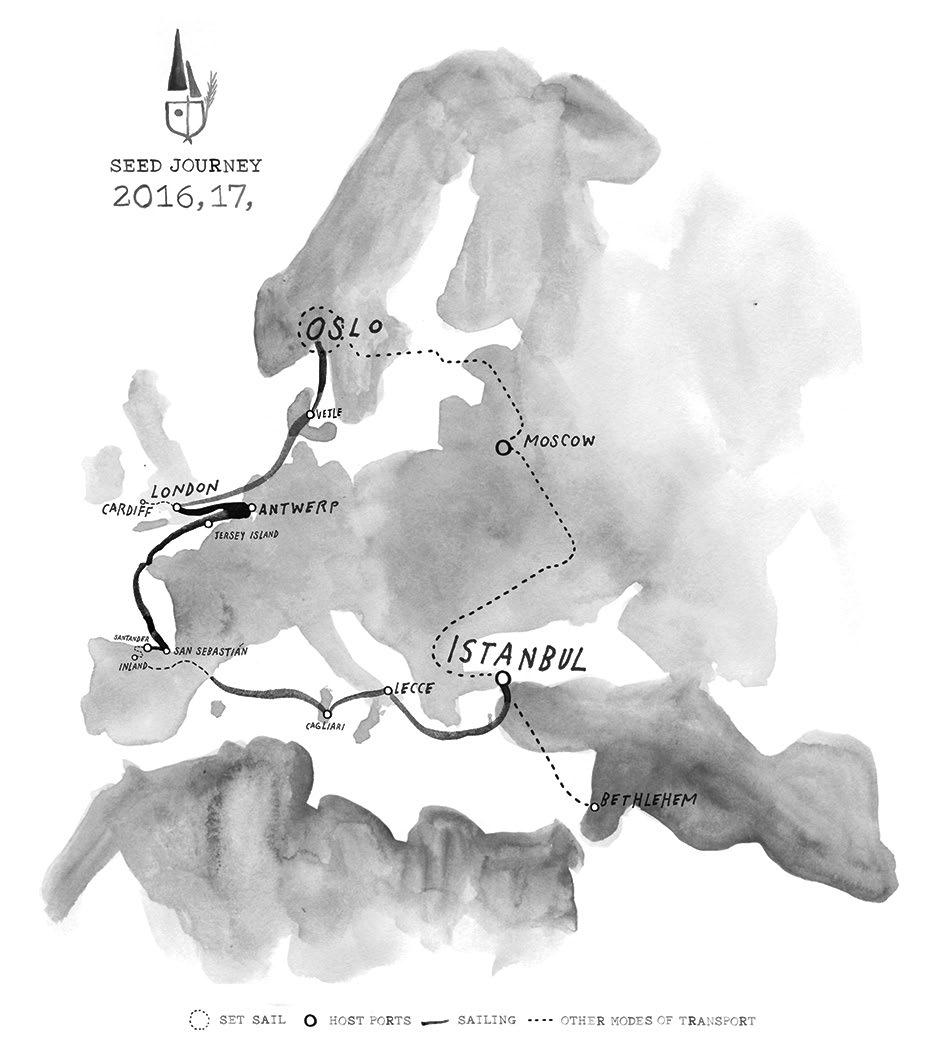


Jibade-Khalil Huffman, We Don’t Need Another Mural, 2019/21 (stills). Multichannel video installation with Astroturf and yard signs; 22:49 mins., 10:04 mins., 5:25 mins.; 3:21 mins. Image courtesy of the artist and Anat Ebgi Gallery, Los Angeles. Image description (top): Two images of the same person wearing a black VR headset are collaged on top of the other. In the background, a larger image of the person faces right-of-center and the frame is cropped from their shoulders. In the foreground, the person is pictured from the waist up, and raises their right hand, gesturing upward with two fingers. The background features a concrete wall and shaded foliage with a raised highway in the distance. Image description (bottom): Two yard signs for West Louisville Women’s Collaborative. The sign on the left is of a preadolescent child wearing glasses and smiling with a blue bow in their hair who holds a sign that says “West Louisville is…A great place to learn and live!” with three hearts drawn beneath the words. The other sign features an adult holding a child. The adult holds a sign that reads, “West Louisville is… more than what u see on the news.” 34
35 create situations in which exchange is possible and even necessary, operating through trade, educational programs, shared voyages, and occasionally, through the production of objects. As the collective’s name implies, Futurefarmers is interested in growth, the cultivation and circulation of ideas, and the conception of possible futures. LRHG
Jibade-Khalil Huffman
It makes sense, viewing the works of Jibade-Khalil Huffman, that the visual artist was first a poet. Working now with installation, video, and photography, as well as language, Huffman does not put forth narratives. Rather, he continues to communicate through strings of idioms, stanzas of unfinished phrases, and nested layers of images. These segments, arranged by the artist, serve to interrupt, complicate, obscure, or complete one another. Huffman’s montages of imageries, surfaces, and sounds offer up partial pieces of information that the viewer may—or may not—choose to loop together into meanings.
Flipping through channels, spinning the dial of the radio, or scrolling through a social media feed become apt analogies for Huffman’s collage-like video works that conflate various streams of input, historical moments, and spatialities. We are able to pick out bits of sight or sound that key us into Huffman’s interests in culture, history, and community. His video installation We Don’t Need Another Mural (2019/2021) which sketches out a fragmentary portrait of a community in Louisville, Kentucky, takes up issues of race, resources, and access in ways that are both particular and universal. His constructions remain suggestive but not prescriptive, their open structures echoing the spareness of a poetry that is as determined by its blank spaces as its words. LRHG
Baseera Khan
In its presence and absence, Baseera Khan’s own body is employed as medium and subject to create the potential for resilience, agency, and expression as a queer Muslim femme entrenched in America’s converging systems of marginalization and oppression. It’s fitting that collage is a central de/constructive tool in their practice, as it manifests the many identities Khan represents and the rupture and volatility that is felt in navigating this hostile world filled with often opposing expectations.
How can one represent and disseminate the conflicting experiences of a femme Muslim in this country? In Braidrage (2017–18), Khan cast 99 molds from the edges of their own body and used them as rock climbing holds, scaling them in an endurance performance wearing Nike iD Air Force Ones embroidered with the word “iamuslima.” Khan used the title to circumvent Nike’s list of banned words (including “Islam” and “Muslim”) seen by the company as “content construed to incite violence.”* The shoes were appropriate gear for an enervating performance that requires training and pushes the artist’s body to the point of physical exhaustion.
Khan’s work does not exclusively meditate on anger and alienation; faith, spirituality, and conviviality are also important themes. Khan has made burqa-like shrouds from acoustic sound blankets; they created a Karaoke Spiritual center; and, most recently, Khan recorded the pilot for a television series in a simulacrum of their own apartment featuring conversations with friends in the midst of the global pandemic. LZ
*Jane Ursula Harris, “Baseera Khan,” Art in America, May 26, 2017, https://www.artnews.com/art-in-america/aia-reviews/ baseera-khan-62356/.
Carolyn Lazard
Often relying on recognizable images and objects from institutional settings like hospitals and prisons, Carolyn Lazard implants an infrastructure of care into the museum, rethinking how its site can be adapted as a model of accessibility. More specifically, their work considers how disability and illness can be reconceptualized as a source of new potential.
Through the lens of disability politics, Lazard critiques the social significance placed on productivity, usefulness, and reciprocity—capitalist values that ultimately prioritize certain bodies over others. By modifying devices that are typically used to serve these ideals, the artist queers capitalist ambitions that seek to control the body and reform it into standardized modes of production.
Integrating personal histories and sometimes archival research, Lazard’s work questions current concepts of accessibility and their points of intersectionality, asking essentially, who is accessibility centered on and how can that center be subverted? How can accessibility be reformulated in a way that prioritizes pleasure and joy over rights and compliance? Through their work, Lazard explores how time and space can be transformed in ways that allow for alternative forms of being, doing, and living. SK
Park McArthur
Which bodies and what forms of cognitive diversity and neurodiversity are being served? What information is being prioritized? Whose abilities and needs are being considered?
Informed by her life experience with a physical disability, Park McArthur addresses these questions and
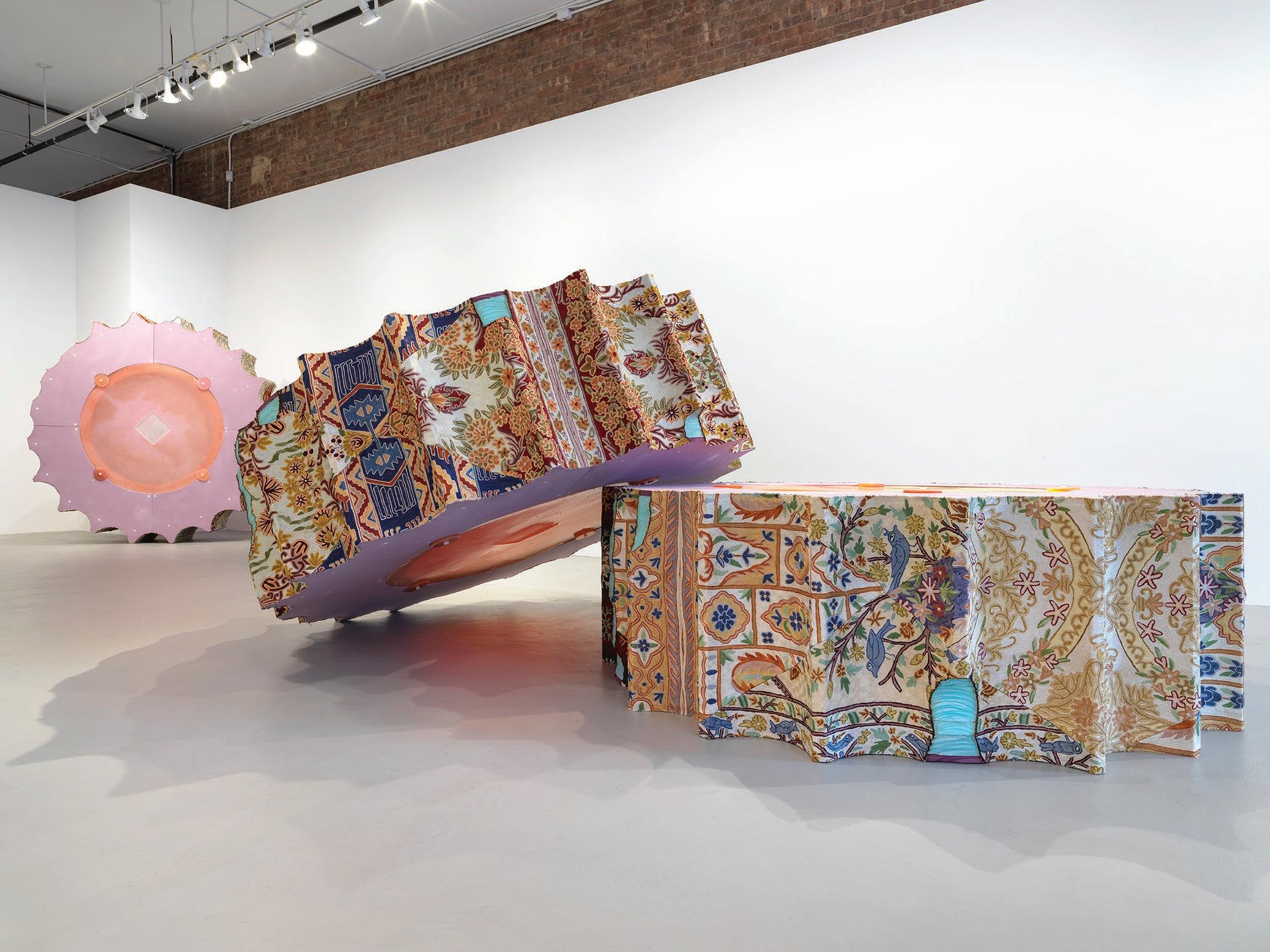
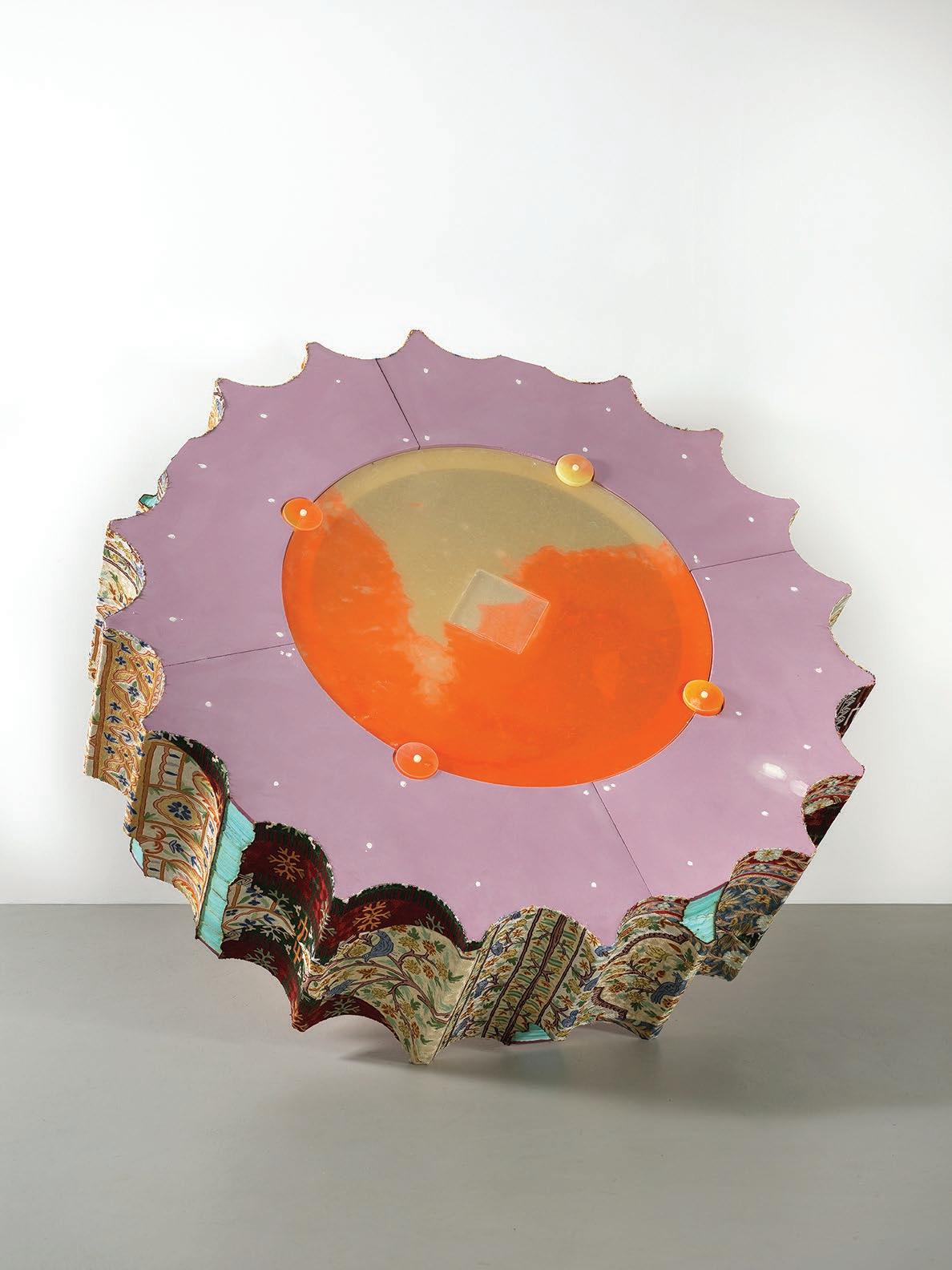
ABOVE
Baseera Khan, installation view of Baseera Khan: snake skin, Simone Subal Gallery, New York, 2019. Image courtesy of the artist and Simone Subal Gallery, New York. Photo: Dario Lasagni.
Image description: Three sculptures on display at a gallery. They are round and flat sections of a fluted column. One section is propped up by another that lays flat on the ground. The third sculpture stands on its side in the far corner of the room. The outer edges of each work are wrapped with collaged silk rugs with multicolored floral patterns.
LEFT
Baseera Khan, Column 5, 2019. Pink Panther foamular, plywood, resin dye, and custom silk rugs handmade in Kashmir, India, 72 x 22 x 72 in. Image courtesy of the artist and Simone Subal Gallery, New York, photo: Dario Lasagni.
Image description: Three-quarter view of a sculpture that resembles a column fragment, resting on its side. Its outer edge is covered with collaged silk rugs with multicolored floral designs. There are portions where the rug appears to have been stripped away, revealing bright turquoise foam. The interior of the sculpture is made from mauve insulation foam and a circular piece of orange resin covers the hollow core. 36
37
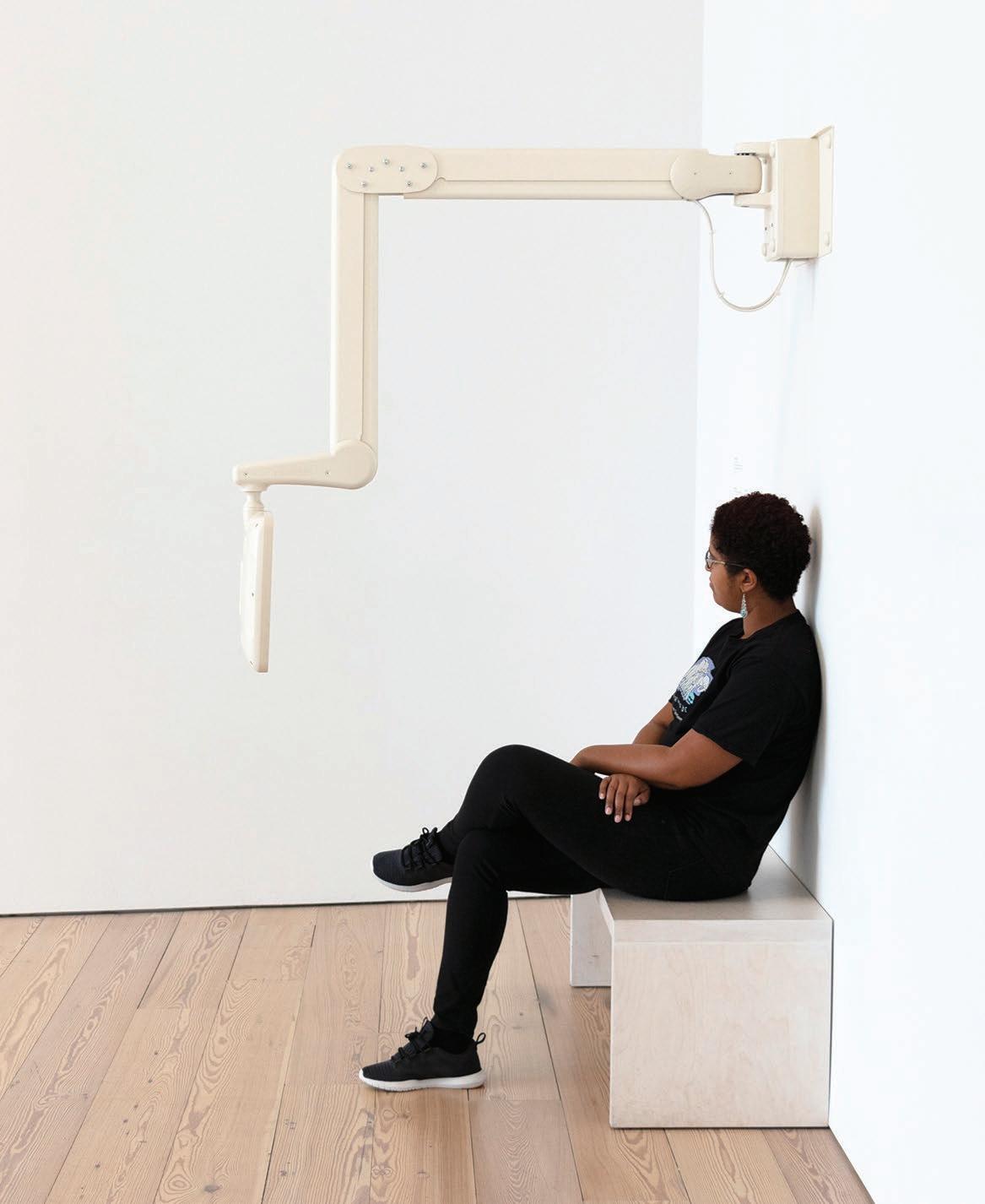
Carolyn Lazard, Extended Stay, 2019. Articulating medical arm mount, personal patient monitor, and basic cable subscription, infinite duration. Installation view at the Whitney Biennial 2019, Whitney Museum of American Art, New York. Courtesy of the artist and Essex Street, New York.
Image description: A person depicted in profile, sitting on a gallery bench. Their arms are crossed, resting in their lap, and their back is against the white wall. Their head is cocked as they look at a flatscreen monitor on a cream-colored articulating medical arm mount that is installed on the wall above their head.
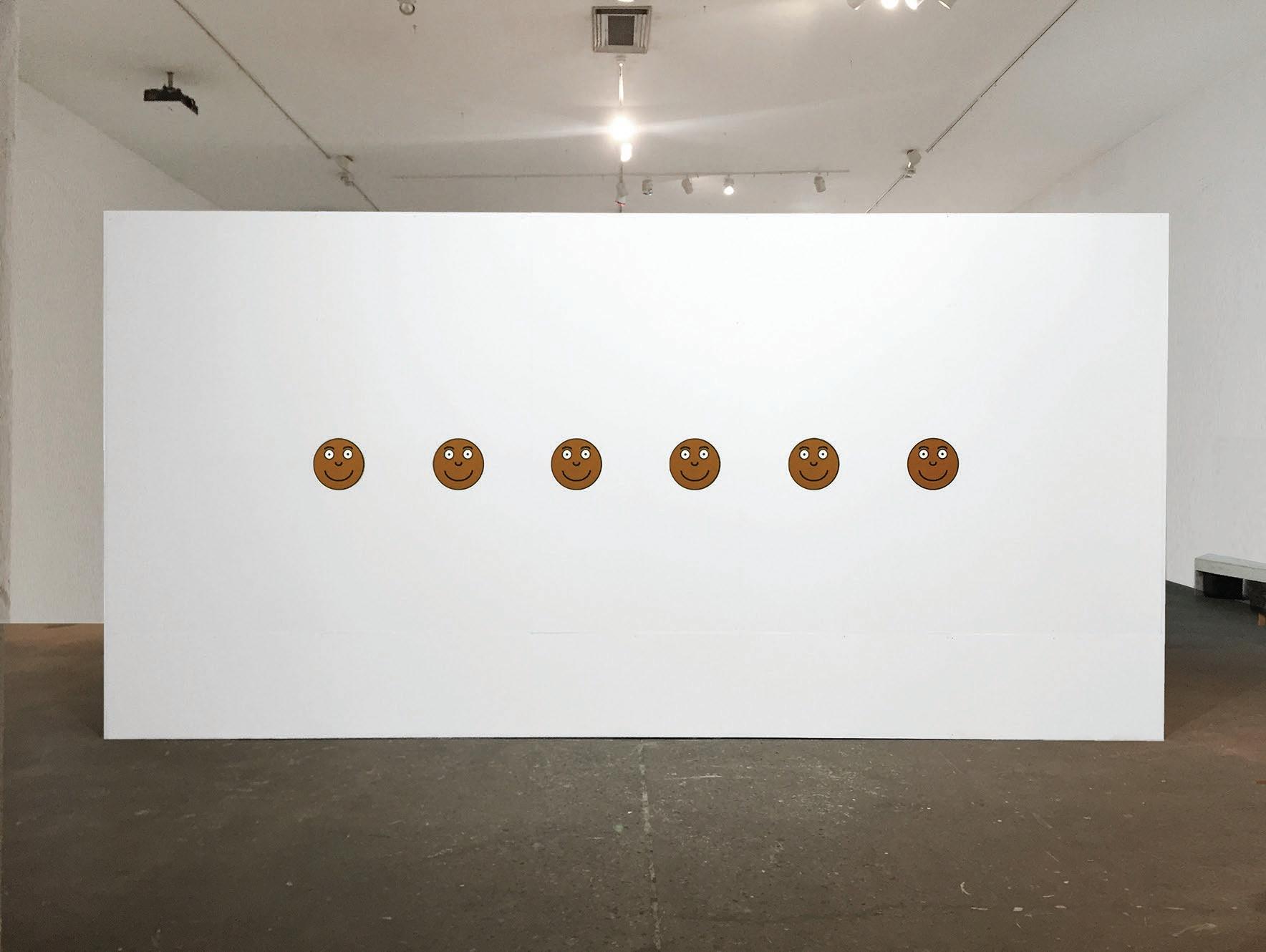
Carolyn Lazard, Pain Scale, 2019. Vinyl decals; six parts, 12 × 12 in. each, 148 × 12 in. overall. Courtesy of the artist and Essex Street, New York. Image description: Installation view of six identical round vinyl decals of a brown smiley face icon, adhered to a white gallery wall in a horizontal row, evenly spaced apart.

Park McArthur, Carried and Held, 2021. Ink on paper mounted to Sytrene board, 40 x 8 in. Courtesy of the artist and Essex Street, New York. Image description: A 40-inch-long museum label installed on a white wall in a gallery space. Text runs almost halfway down the label. 38
39

Danielle Julian Norton, Stage for a Blank Memory, 2019. Wood, wire, mud, ceramic, fan, fish tank, plants, snails, fabric, metal, and speakers, 73 x 120 x 143 1/2 in. Installation view in Double Yellow Line, Angela Meleca Gallery, Columbus, Ohio. Photo: Hanna Mendel. Image description: A wooden sculpture divided into two open rectangular levels. On the left, orange steps rise halfway up the side of the sculpture leading to the back wall and the second level of the sculpture. On the top level of the sculpture is a yellow square of fabric hanging on the left; a smaller turquoise square is painted on the back wall of the top level; an orange beam is positioned horizontally at the top. On the bottom level sits a large brown rounded stone and a small green ladder.
challenges institutional infrastructures in her work. Placed on pedestals, medical items for caregiving and care receiving become intimate monuments to dependency. Disposable air filters from the ventilator McArthur uses to sleep and wheelchair access ramps (some provisionally built for the artist to enter exhibition venues) become thematic connectors bridging states of sleep and wakefulness, individual and public existence, being outside and inside institutions.
Pushing against the preexisting usage of institutional protocols that are often invisible to visitors, McArthur exposes the museum’s assumption of neutrality. By enlarging artworks’ wall labels, disseminating a Wi-Fi password as a wall mural while extending its network beyond the museum’s vicinity, or expanding the audio descriptors in access guides, she underscores the embedded privilege and ableism of institutions. Advocating for access, inclusion, and equity, McArthur calls to action bodies overlooked and sublimated by institutions as agents of change. JT
Danielle Julian Norton
In 2017, Danielle Julian Norton purchased 30 acres of land in Appalachian Ohio and called it Zippitydirtdada. Together with fellow artists, Norton is always finding new experimental potential for this land as a feral outdoor studio space meets artist-run practice site. Zippity serves as an asylum from technology and screens and allows for remapping and deepening connections with the environment as much as with fellow artists and the local community in Southeast Ohio. She and her collaborators have hosted workshops on kiln-building; mapping the land, creating pathways, and documenting water quality with area organization Rural Action; plant identification; and more.
Norton’s impetus for Zippitydirtdada arose from her investment in living an ecologically conscious life, her curiosity about alternative models of living and working that sprung up through the counterculture of the 1960s and 70s, and her thinking about how she could tend to what is immediately around her following the presidential election in 2016. Her recent sculptures and installations reflect that interest in care (and scales of care) within ecosystems. Combining such elements as dripping water, aquariums, living plants with grow lights, and even a spinning beer can, Norton’s platforms and scaffolded structures are Fluxus-style studies where process meets DIY abstraction, often with a welcome dose of offbeat humor. LZ
Pope.L
“Have-not-ness permeates everything I do.” —Pope.L
In 1978, Pope.L crawled along the streets of New York, traversing 42nd Street as his skin and pinstriped suit scraped across the pavement. This performance, Times Square Crawl, marked an early instance of the artist testing the limits of his physical endurance. After nearly three decades of crawling on the street, tying himself to an ATM, and ingesting newspapers, Pope.L has expanded his practice beyond performative actions to create texts, drawings, paintings, installations, and sculptures that similarly enact the socially absurd, destabilizing conceptions of reality prevalent in the United States and their perceived state of normalcy. Residing somewhere between the humorous and the unnerving, his works have addressed a wide range of topics, including the precarious position of the Black man in public space and the harmful conditions of America’s capitalist culture.
Claiming to take advantage of his own “have-not-ness,” as he describes it, Pope.L has often used whatever resources might be at his immediate disposal. In the past, that has included his own body (Times Square Crawl), edible condiments (Map of the World, 1999–2000), or water from the Flint River (Flint Water Project, 2017). It is through this emphasis on his own lack—whether that might pertain to a lack of materials or a lack of social power—that he makes once-invisible cultural forces palpable and political. Through these artistic explorations, he critiques the contradictions at work in unjust systems of power that create strict binaries between the “haves” and “have-nots.” Pope.L specifically sees Blackness as a state of have-not-ness, one in which he finds simultaneous pain, joy, failure, and opportunity. SK
Raqs Media Collective
Based in Delhi, where it came into being in 1992, Raqs Media Collective is Jeebesh Bagchi, Monica Narula, and Shuddhabrata Sengupta. Here’s how they unpack the group’s name: “Raqs is a word in Arabic, Turkish, Persian and our own Urdu that denotes a whirling, a dancing, a practice and cultivation of ecstatic contemplation founded in kinesis. So our name, our artistic signature, comes from the whirling—the Raqs— of whirling dervishes.”*
Sensitivity to language and its traditions (and to the perpetual global imperatives of translation) commands a central role within Raqs’ public projects, which deploy a dazzling array of expressive media: moving images, photos, banners, installation forms, symposia, publications, sculptural interventions, and, preeminently, words. The collective’s most heartfelt instincts embrace spoken and written language (from fiction, philosophy, poetry, mysticism, and journalism…just for a start), making those idioms and tongues theirs and their viewers’ own property, 40
41
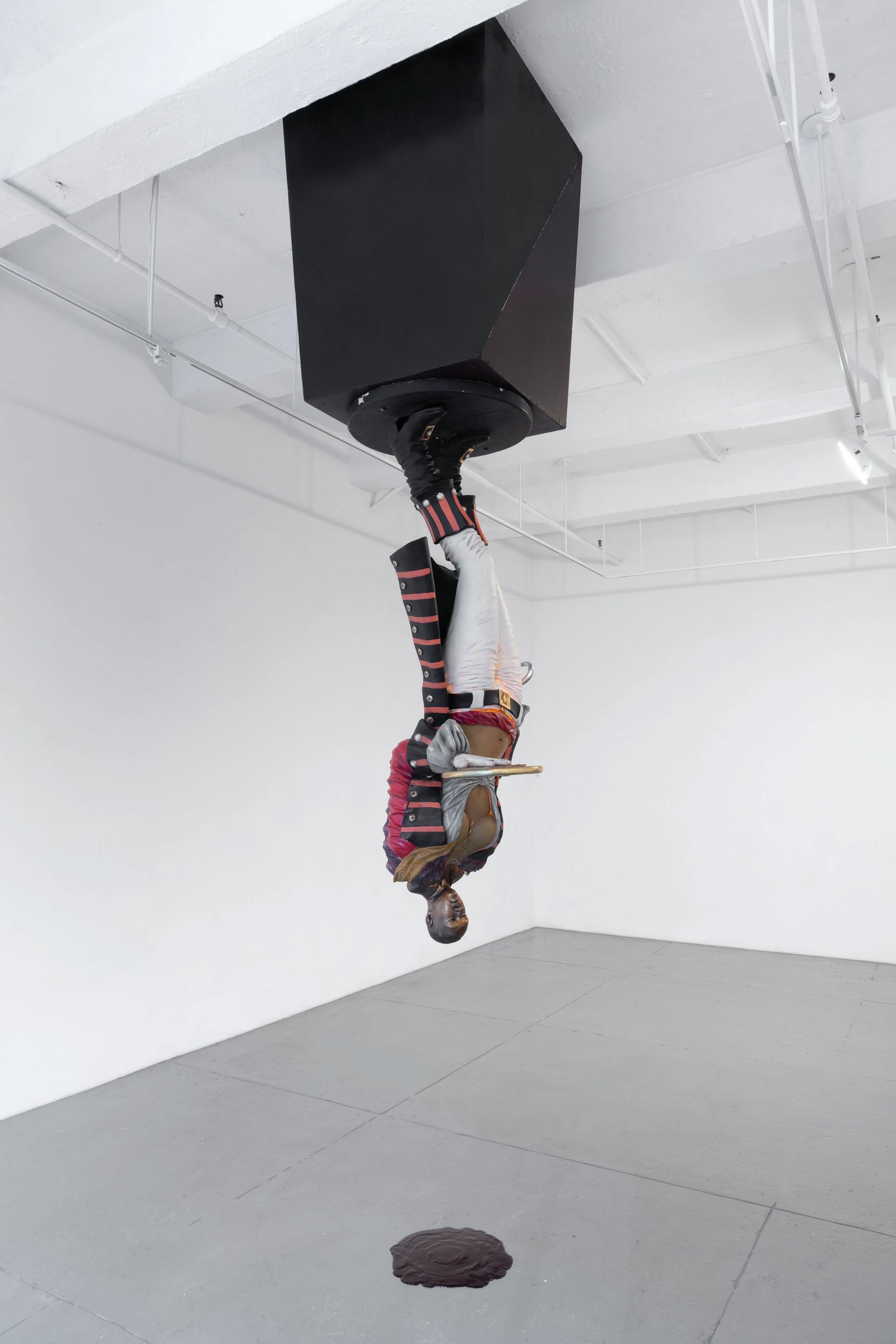
Pope.L, A Vessel in a Vessel in a Vessel and So On, 2007. Pirate lady statue, Martin Luther King Jr. plaster bust, wood, pump, light, and liquid chocolate, 113 1/4 x 33 x 28 in. Courtesy of the artist and Mitchell-Innes & Nash, New York © Pope.L. Image description: A sculpture of a figure standing on a dark pedestal hangs upside-down from the ceiling of a gallery space with white walls and a concrete floor. The sculpture is a female pirate wearing white pants, a red-and-navy open coat, and a button-down shirt tied above the figure's navel with gold necklaces. She holds a tray. The head of the sculpture is a bronze-colored plaster bust of Martin Luther King Jr. There is a puddle of chocolate sauce on the floor directly below the sculpture.
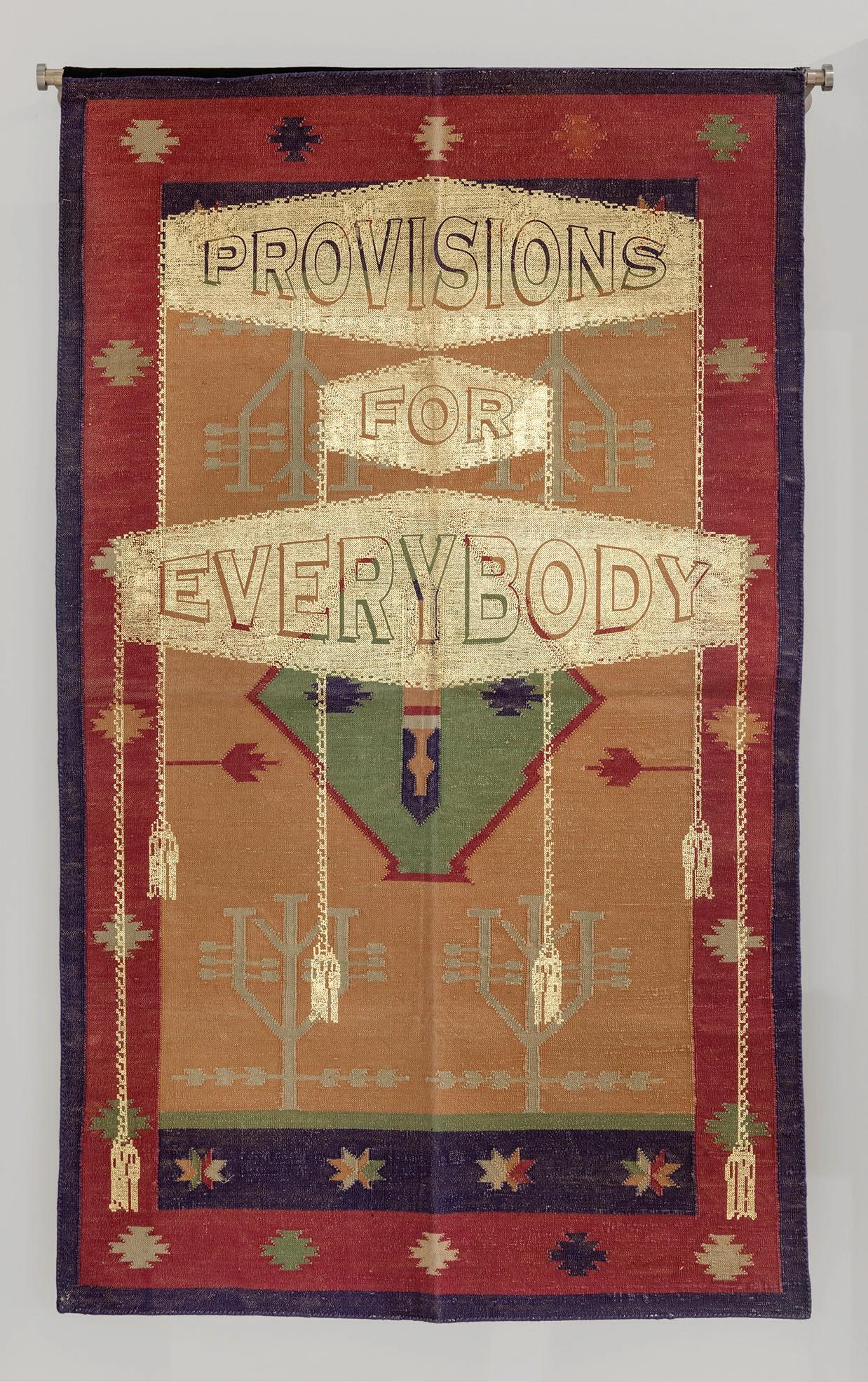
LEFT
Raqs Media Collective, Let the Future Praise Us (2), 2018. Text and gold foil print on handwoven dhurrie, 57 7⁄8 x 34 7⁄8 in. Image courtesy of the artists and Frith Street Gallery, London. Photo: Sebastian Pellion di Persano.
Image description: A dhurrie rug hanging from a silver rod. The rug’s colors are rich red, navy blue, green, and muted orange tones. The words “PROVISIONS FOR EVERYBODY” are printed in gold foil on the top half of the carpet, with printed gold tassels cascading down from the ends of the text.
BOTTOM
Raqs Media Collective, Provisions for Everybody, 2018 (still). 4K video with color and sound, 53:11 mins. Image courtesy of the artists and Frith Street Gallery, London.
Image description: Four large rock formations spaced equidistantly in tall, yellow grasses blowing in the wind. In the top left-hand quadrant of the film still there is a white text caption that reads “Anybody, everybody, somebody, nobody have stood their ground in the wind, and are still standing.” 42

43 and in that way sustaining binding threads among post-postcolonial citizens within the global drift.
In the collective’s Provisions for Everybody, the eavesdropping and admired literary presence is George Orwell, whose path to socialism followed his return to England in the mid-1930s after serving almost six years in the Indian Imperial Police in Burma. Raqs’ luminous video is a meditation on his hard passage on the road from Mandalay to Wigan Pier, drawing from his writings on “living labour, dead labour, and, yes, ghost labour.” With the onscreen text declaring “from Burma to Barcelona, everything is burning,” Raqs narrows the focus, joining their own words to Orwell’s to produce a lyrical and unsentimental commentary on want and abundance, growth and waste, restoring and destroying, all witnessed around our common world as they found it in 2018. BH
*Shuddhabrata Sengupta, “Learning from the Horizon: Practicing Art. Imagining Politics” (talk, 2nd FORMER WEST Research Congress, Istanbul Technical University, November 5, 2010).
Related Tactics
Formed in the Bay Area in 2016, Related Tactics describes itself as “a collective of artists and cultural workers producing creative projects, opportunities, and interventions at the intersection of race and culture.” In its earliest statements, the term “provocation” crops up repeatedly, posing the group’s interventions in the future tense—as contributions to a cultural-political reckoning still in gestation.
Their project Declarations for the New Year, an exhibition cocurated with San Francisco’s Southern Exposure in January 2016, consisted of affirmations and negations authored by 40 individual contributors, “a gathering of provocations” that included declarations of BIPOC futurity—“THRIVING AS AN ARTIST OF COLOR IS MY RADICAL PRACTICE”—alongside warnings to the 1%—“ART PAID FOR BY YOUR PARENTS DOESN’T COUNT.” The following year, the collective conceived an exhibition of printed messages—again, “provocations”—questioning the artworld’s commitment to institutional diversity, equity, and inclusion. In the wake of protests over the 2020 police murder of George Floyd, these provocations have lost none of their power; only their tense has changed. As the Black Panthers used to say, “Seize the time!” DM
Jacolby Satterwhite
Jacolby Satterwhite merges performance, animation, and personal archives to create a queer virtual reality. In this alternate world, bodies thrash, twirl, and intertwine to produce a conglomeration of avatars that are multiplied ad infinitum, enhancing the surreal qualities of his digital landscapes. Some of these figures are engaged in a range of sexual acts, while others endlessly dance, gyrating to the groove and twisting their bodies into impossibly contorted poses. The various actions displayed throughout his settings seem to demonstrate the potential resonances that exist between ritualistic performances, sadomasochistic deeds, and ballroom voguing.
To construct these environments for his videos, installations, and virtual realities, Satterwhite uses a range of visual sources, including materials left behind by his mother, who composed songs and illustrated her own consumer products as a means of coping with schizophrenia. By integrating the remnants of his mother’s documents into his own augmented realities, the artist commingles the categories of private and public, personal and collective, and real and imagined into a queer technotopia. Through his work, Satterwhite explores the prospects of a queer Black future where time, space, and bodies become boundless through a series of entangled, collaborative networks. SK
Sable Elyse Smith
Sable Elyse Smith exposes the injustices imposed on Black lives through her drawings, photographs, videos, and sculptural installations—works that serve as acts of resistance against systemic racism and the multibillion-dollar prison industry in the United States.
Growing up visiting her father who was incarcerated for 19 years, Smith casts the logic of the prison-industrial complex into doubt by intertwining this personal history in her art. Her works challenge the status of things— reconfiguring objects, pushing against the limits of language, manipulating the video form. Sculptures such as ScapeG.O.A.T. (2019) twist prison visitation tables into shapes evoking clusters, rhizomes, and portals. By also recalling metal detectors and playground equipment, the ongoing series of sculptures frames the African American experience and state violence against Black and brown families within what theorist Jackie Wang calls “carceral capitalism.”*
A poet of words and moving images, Smith breaks down the rhythm of language and temporality with a forensic simplicity that also lays bare the construction of desire and queer intimacy. Language appears as a body in a landscape, and videos play as ruptures of time and memory, as in all her defiant works that operate as resistance on refrain, on a constant loop. JT
*Jackie Wang, Carceral Capitalism, Semiotext(e)/Intervention (Cambridge, MA: MIT Press, 2018).
Constantina Zavitsanos
Foregrounding abundance in a world that exploits and monetizes lack and depletion, Constantina Zavitsanos makes space at the limits of human perception to forge a shared alliance of our senses—providing a way out of the binary notion of dis/ability while underscoring access as a model of interdependency.
Through sculptures, performances, and works that incorporate sound and text, Zavitsanos tackles systems of care, disability, and debt, using these themes as materials and also treating institutions as mutable bodies. In addition to gestures of care such as lowering works to wheelchair height in compliance with the Americans with Disabilities Act (ADA) and prioritizing American Sign Language (ASL) interpretation and Audio Description (AD) as in their 2019 exhibition L&D Motel at Participant Inc., New York, Zavitsanos collaborates with artists who take capacity and debility as a framework, including Carolyn Lazard and Park McArthur.* Together, they enlist networks of care where each other’s needs are understood, calling attention to what Disability Justice activist Mia Mingus calls an “access intimacy.”
Several of Zavitsanos’s works activate the sensorial dimensions of scientific concepts such as quantum entanglement—in Interferometer (Quantum Eraser) (2018), made with Amalle Dublon—or point to the threshold of human perception—as in the installation Call to Post, on view in Climate Changing, which uses infrasonic frequencies that operate below our audible spectrum. In so doing, the artist centers a sense of agency and liberation that is experienced both in and out-of-body while deftly enacting the politics embedded in visibility and legibility—creating bonds beyond measure between those experiencing their works via interference and interdependency. JT
*Jasbir K. Puar uses the term debility to disrupt the binary of ability/disability as well as to think about how systemic inequity and injustice wear on bodies over time, particularly under capitalism and its demands for bodily capacity. See The Right to Maim: Debility, Capacity, Disability (Durham, NC: Duke University Press, 2017).
Contributors
Liz Rae Heise-Glass (LRHG) Bill Horrigan (BH) Stephanie Kang (SK) Daniel Marcus (DM) Jo-ey Tang (JT) Lucy I. Zimmerman (LZ) 44
45

Allan deSouza for Ready, 2020, a project by Related Tactics. Inkjet print, 33 x 44 in. Courtesy of the artists. Image description: Cropped black-and-white photo of an envelope with the words “OFFICIAL ELECTION MAIL” and in smaller letters below “Authorized by the U.S. Postal Service” with three gray, wavy forms and stars behind the text, and a check mark running through the O in the word “election.” Handwritten in black ink are the words “TAKE COVER” using the O and check mark to spell the phrase. Partial text below reads “VOTE BY MAIL BALLOT MATE...” and there is a bit of barcode visible in the bottom left of the photo.

Jacolby Satterwhite, Throne, 2019. LED, plexiglass, silicone, velvet chairs, carpet, and plastic plants. With Domestika, 2017, HD virtual reality color video with sound. Installation view of Room for Living at the Fabric Workshop and Museum, Philadelphia, 2019. Courtesy of the artist; the Fabric Workshop and Museum, Philadelphia; Mitchell-Innes & Nash, New York; Morán Morán, Los Angeles; and Lundgren Gallery, Palma de Mallorca. Image description: Dimly lit room with two people seated in black swivel chairs, holding VR headsets covering their eyes. There are potted palm plants on a black area rug on the floor that sit in between two people, and the wall behind has an LED sculpture mounted on plexiglass that says “Throne.”

Sable Elyse Smith, Landscape II, 2017. Neon, 16 x 108 in. Collection of Antonia Josten. Image courtesy of the artist; JTT, New York; and Carlos Ishikawa, London. Image description: White neon text glowing against a wall reads “Planking or the lying down game” and hovers above a single thin yellow neon line. Electric cords trail down from the sculpture to black transformers on the floor.
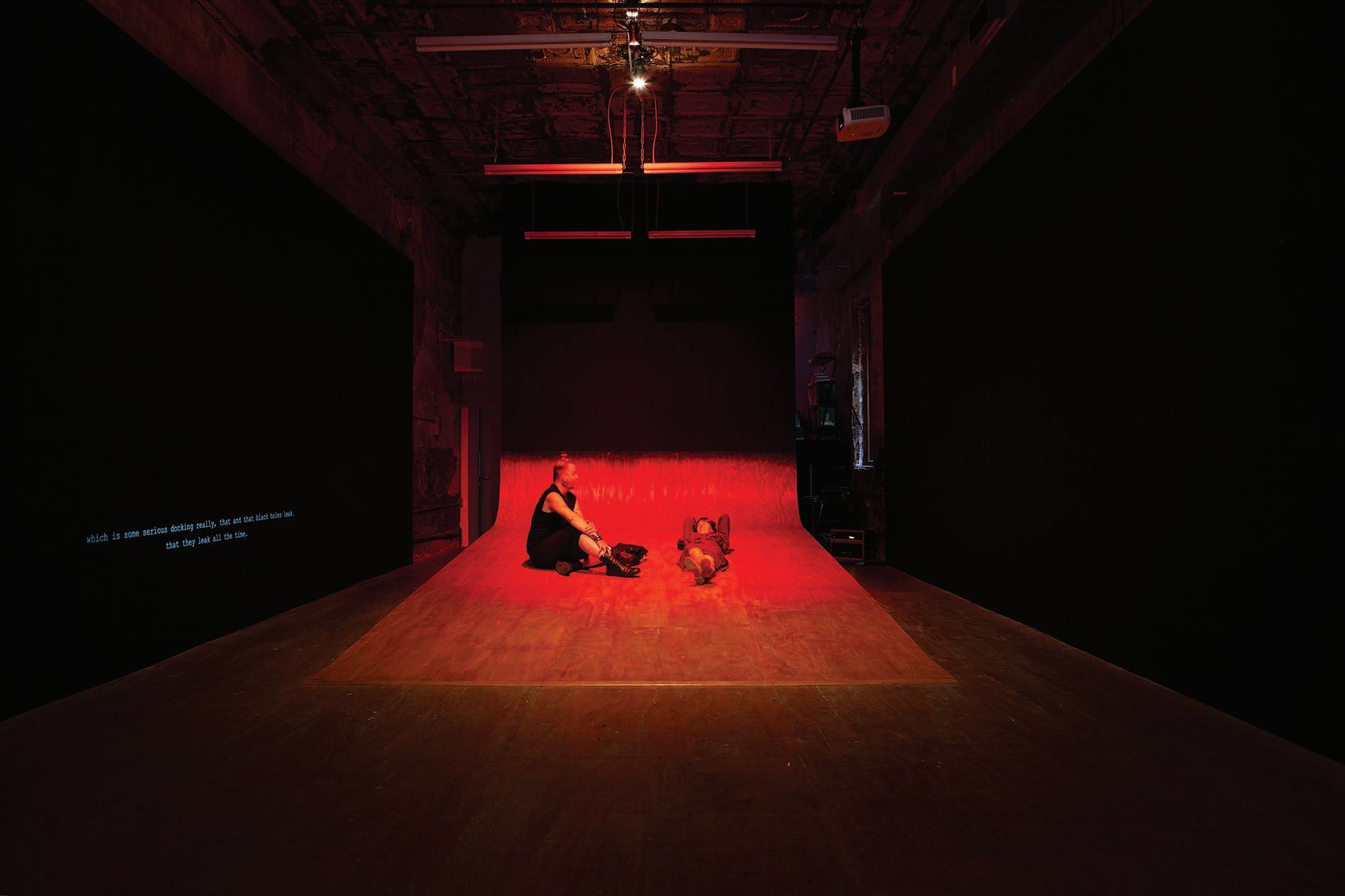
Constantina Zavitsanos, L&D Motel, 2019. Installation view, Participant Inc., New York. Image courtesy of Participant Inc., photo: Mark Waldhauser. Image description: A darkened gallery space with black walls, wooden floor, and red light. White open captions are projected dimly onto the left wall. A wooden ramp curls up the back wall. Two people are mid-way up the ramp; the person on the right reclines with arms behind their head and feet facing out front, and the person on the right sits upright facing their friend. Two corridors flank the back wall. A soft red glow fills the space behind the back wall. 46





